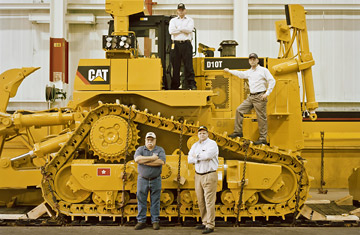
Caterpillar workers at the company's recently expanded plant in East Peoria.
(3 of 7)
But in the U.S., the shifts in banking may be a happy event. Too-big-to-manage institutions may be reined in or even split up, allowing smaller entities to focus on what they do best, be it high-flying trading or local lending. (Being closer to the ground, such commercial banks will know their consumers better, which could mitigate risk and increase capital flows to small businesses.) As profit margins shrink, the fees banks charge may get higher. But banking may also become more the way it is in It's a Wonderful Life, "which has certain advantages in terms of reconnecting people back to their local communities," says Atwater.
RULE NO. 2
Manufacturing Matters
As finance fades into the backdrop, manufacturing takes center stage, and each hometown accomplishment brings crucial carryover effects for the surrounding economy.
It's not being overly dramatic to say that the world is on the verge of a new industrial revolution as manufacturing regains its traditional role as a global growth driver. Manufacturing's share of global output is 17.4%, the highest it's been in over a decade. The growth has been driven not only by China but also by the U.S. (the second-biggest factory nation by output), which got a boost from the government's Detroit bailouts. Indeed, if the U.S. manufacturing economy were a nation, it would be the ninth largest in the world.
Government support is certainly one of the reasons for the boom. Manufacturing is politically very important because it's one of the few areas of the economy that is creating solid middle-income jobs. (See Rule No. 3. Export-oriented jobs pay 9% more on average.) The reason the latest U.S. jobs numbers aren't worse than they are is that Detroit has been holding its own. A weaker dollar and more-competitive global wage rates have also helped U.S. manufacturing, as have two other key trends: the rise of emerging markets, which buy a growing chunk of American exports, and a homegrown energy boom in shale gas and oil, which is goosing other parts of the economy like commercial construction and agriculture. This underscores manufacturing's important spillover effect for the rest of the economy. The Bureau of Economic Analysis calculates that every $1 of manufacturing GDP drives an incremental $1.42 of activity in the nonmanufacturing economy.
That fact was recently heralded by, of all people, Airbus CEO Fabrice Brgier in a July 2 announcement in Mobile, Ala., where the European aircraft giant is opening a new plant, citing a more competitive labor and growth climate in the U.S. as compared with Europe. It was a bitter day for the French and the Germans. Manufacturing is a key source of innovation, accounting for 70% of private-sector R&D and 90% of patents issued in the U.S. When a high-end manufacturing operation like Airbus sets up shop in a community, the benefits stay disproportionately within the local ecosystem. Spillover benefits decline by half when you go 700 miles beyond a manufacturing site, according to economist Wolfgang Keller.
So how to create more of these local hubs? Ensure access to a highly skilled labor force, connect educators to job creators, and help smaller businesses become suppliers to big firms. (See Rules 3 and 4.)
RULE NO. 3
Blue Collar Jobs Go High-Tech
